The Buffer blog brings in 10x the traffic of the Open blog. It has 50x the reach of our email courses. A single post on the blog reaches more people in a day than we reach on Facebook in two weeks.
It is our greatest marketing asset.
And we just keep changing it.
We’re pivoting right now, as we speak! The latest change, which I’m excited to share below, fits with this remarkable culture of experimentation, where there are no sacred cows or off-limits areas. Everything is on the table to improve and iterate.
Even a thing that works really well.

You can’t connect the dots looking forward you can only connect them looking backwards. So you have to trust that the dots will somehow connect in your future.
You have to trust in something: your gut, destiny, life, karma, whatever. Because believing that the dots will connect down the road will give you the confidence to follow your heart, even when it leads you off the well worn path.
– Steve Jobs, Stanford commencement address 2005
Everything will work out the way it needed to
This sentiment—change as a necessity—began with a comment from an interview, where a candidate shared how his life has worked out the way it needed to. What an incredible thought. I can see the same being true in my life; I can see the same being true for things like the blog.
We grow and mature as people, changing all the time.
Could the things we create—blogs, campaigns, channels—do the same?
The above quote from Steve Jobs seems to fit in quite well when thinking through this idea of always pivoting the Buffer blog. We pivot and change because we believe that it’s the right thing to do. We pivot toward something we believe in, and we hope that the dots will connect later on as we look back on the path that we’ve forged.
Why we’re excited to change something that’s working
Of course, there’s a chance the Buffer blog could become New Coke.
Whenever you alter something that’s proven to work, you run the risk of creating something that doesn’t work, something that people won’t like.
I imagine the folks at Coca-Cola had all the best intentions when they spun off a new recipe for their soda. Yet people didn’t like it. It didn’t work.
There’s risk in changing a known commodity.
Think about your best-performing marketing channel. When was the last time you iterated on it?
(And how did it go?)
We do our best to lessen the risk of any experiment on the blog by informing our decisions with data and context, and we find that the potential benefits of pivoting and iterating outweigh any downsides.
Here are three main reasons why we’re excited to always be pivoting, even on the things that work.
1. You can learn fast
We love the idea of learning fast at Buffer. This can be as simple as sharing blog post outlines with one another today instead of waiting til Friday to share the full draft. It can be as big as changing an editorial strategy over a weekend, versus trying a new article every now and then for a few months.
The great thing about experimenting with your top channels is that you’re likely to have a lot of great traffic or reach, and you can quickly see the effect of any change or iteration.
2. You can have a bigger impact
One way that we think about goals at Buffer is to find intriguing metrics on a grid of traffic and conversion. This chart helps break it down:
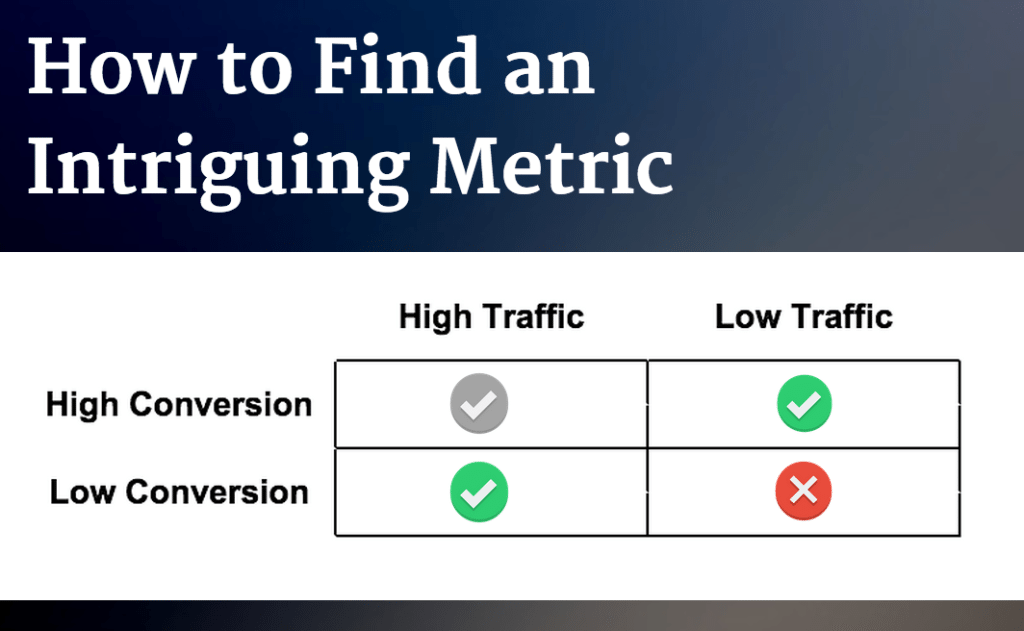
- High traffic, low conversion
- Low traffic, high conversion
- High traffic, high conversion
- Low traffic, low conversion
The first two buckets are the ones where you find the biggest opportunities for growth. Bucket No. 3 isn’t half bad either. Bucket No. 4 is best to be left alone.
Two of the three best buckets here involve high traffic. Your go-to marketing asset is likely to be a high traffic area. We’re fortunate to have high traffic on the Buffer blog, which gets us excited to try new things to see if we can boost the traffic and/or boost the conversions.
3. You can double down on what’s been validated
We know that the Buffer blog works great for gaining traffic, awareness, and signups for Buffer.
All our pivots and experiments and changes, then, are intended to drive those numbers even higher.
Whenever you start with a new marketing channel, you begin at the exploration stage. Once you find what works, you go full speed into the enhancement stage.
I like the way that Ryan Holiday puts it in his book Growth Hacker Marketing. In describing the process of one company in his case studies:
They merged marketing into their product development; they kicked off growth with early adopters; they added viral elements; and then they relentlessly repeated these cycles, always guided by the data, with an eye toward optimization.
“Relentlessly” sticks out in my mind.
Can we be relentless with our cycles of optimization?
That’s the idea behind changing these major marketing assets. Since we’ve already had success in these areas, how can we get more? We’ve found it’s better to throw more resources at something that works than it is to invest big in an unknown.
The many different ways a blog can change (we’ve done them all)
I had always struggled to ride my bike up a hill. I’d get going on the incline, lose all my momentum, and end up walking the bike up to the top.
Then I found out the secret: it’s best to shift gears before you get to the incline.
You have to shift earlier than you think, otherwise you end up with no speed, no momentum, and lots of difficult pedaling to do. You can still get to the top that way, it’s just a lot easier if you shift gears early.
The same can be true of iterating and pivoting with your marketing.
With the Buffer blog, we’ve done our best to shift gears ahead of any hills, to stay ahead of the curve with our content. There are several different ways these pivots have occurred. I’ve found there to be five ways (and probably more) that a blog can change and grow.
- Topic: What will we write about?
- Audience: Whom will we write to?
- Style: What types of content will we publish?
- Depth: What level of depth will we approach a topic?
- Behind-the-Scenes: How will we organize ourselves to get the work done?
Here’s how we’ve approached each of these changes.
A history of pivots
1. The evolution of the Buffer blog’s content topics
Tracing the timeline of the Buffer blog from where it started with Leo over four-and-a-half years ago to where it stands today, you can see a lot of fundamental changes, particularly in the content of the site.
1.) Twitter tips: January 2011 – October 2011
2.) Pivot to: Social Media tips: November 2011 – June 2012
3.) Pivot to: Lifehacks, writing, customer happiness and business: July 2012 — March 2014
4.) Pivot to: Social media marketing and content tips: March 2014 to now
(The design has changed a lot, too, which is fun to reflect back on.)

We had an interesting bit of data and background on the why behind the latest change to exclusively social media content:
- Lifehacking and productivity posts spread far and brought in lots of traffic
- Social media articles aligned with the product and had great conversion rate
So what’s a blog to do?
We split off lifehacking and productivity to the Open blog (which has gone through many iterations of its own) and focused exclusively on the social media and content articles. We were excited for the challenge of making the Buffer blog synonymous with social media advice, which has been a great driving principle for us ever since.
2. The evolution of the Buffer blog’s audience
Who is the audience I have in mind when I write a Buffer article?
I don’t know.
I’ve not been very persona-focused at all with the articles that I’ve written. My best guess for an audience is largely based on intuition and feel; there’s been very little discipline.
Sounds like a perfect opportunity to pivot. ?
This figures to be the next step for us on the Buffer blog, where we’re writing articles with a specific person in mind. I’m a bit early on thinking through who these people are, though I’m happy to share some notes from a recent team chat on who we imagine the readers of the blog to be:
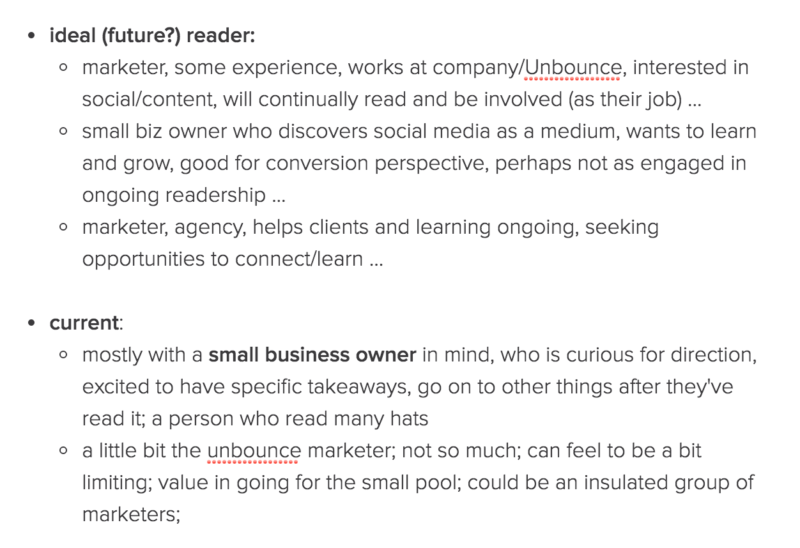
3. The evolution of the Buffer blog’s style
What’s the next wave of content marketing?
I haven’t a clue, but I’m excited to figure it out.
This is how we’ve approached the style of the Buffer blog for some time now. Leo and Belle were so great at discovering the unique ability of in-depth content and clickable headlines. A more recent shift for us occurred a year or so ago when we came to focus on the visuals and images within the article.
What could be next?
Possibly:
- Slideshares
- Audio
- Courses
- Video articles
Or even:
- Hangout On Air office hours
- 1:1 Slack chats
- WhatsApp newsletters
- Periscoped workdays
The point is: I don’t know. And I’m excited to experiment. There’s a bit of unease and discomfort in changing without knowing the outcome or experimenting without knowing for sure you’re on the right path.
4. The evolution of the Buffer blog’s depth
Here’s a bit of a conundrum: Can you write from the same perspective when you’re no longer the same person you used to be?
When you’ve covered the basics of a topic front-to-back, can you still write about the basics with the same perspective you had before?
I don’t have the answers here either (sorry, it seems I don’t have the answers to much of this!). What I’ve noticed is that this idea of personal growth can sometimes match the trajectory of a blog’s growth as well.
For instance, here is one way this has looked for the content we write at Buffer:
- Definitions – Here’s what this means
- Tools – Here’re the tools you can use
- Workflows – Here’s how to get it done
- Future – Here’s where it’s headed
To be honest, I’m not entirely sure what’s after Step 3 (workflows) for us because we’re not quite there yet. Content like our new email course and our strategies articles seem to be this new layer of depth that we’re exploring. We’ve built guides, we’ve shared tools, we’re discovering workflows, and we’d love to know what’s next.
What would you like to see from us next?
5. The evolution of the Buffer blog’s organization
This is where the biggest changes are happening for us currently.
Our latest pivot can be seen most clearly by looking at how our Trello board has changed. It’s gone from one column with a grab bag of great ideas …
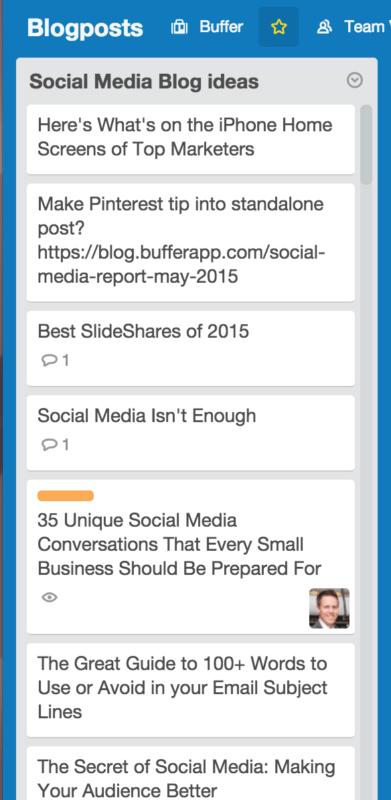
… to a four-column, uber-intentional editorial plan.
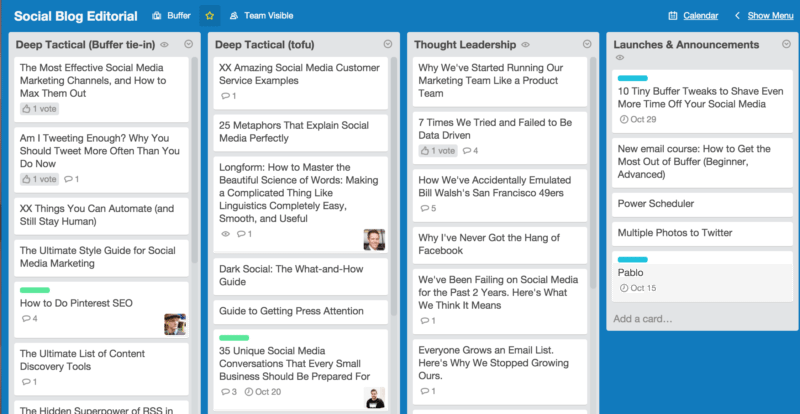
Starting this month, we’re moving full steam ahead onto a new strategy that is data-informed and editorially stout. We even have a publishing calendar (a first for me)!
We took a lot of inspiration from HubSpot’s disciplined approach to its content strategy. The HubSpot team knows where each of its post fits within a particular category of content.
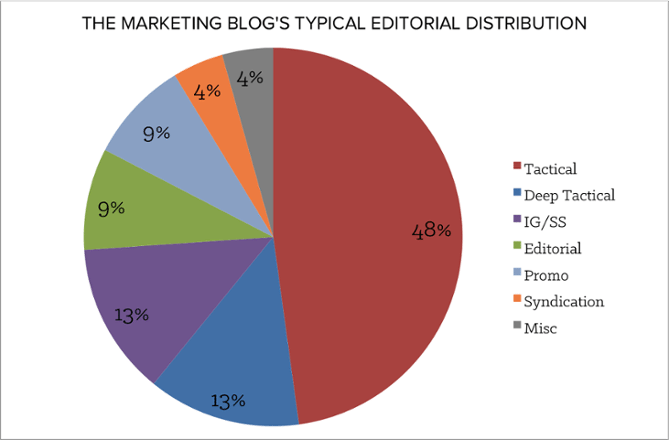
We did some work to come up with our own categories for the Buffer blog:
1. Deep tactical with a Buffer tie-in
These are in-depth posts on a topic that fits naturally with Buffer the product (example: How to Manage Multiple Social Media Accounts). We’ve found these posts convert really well to Buffer customers.
2. Deep tactical for the top of the funnel
These posts are intended to spread far, to gain lots of unique visits and social shares (example: What’s on Rand Fishkin’s Phone?).
3. Thought leadership
These are big-picture ideas and vulnerable stories of what we’re learning and thinking about social media and content (example: This post!).
4. Launches and announcements
These have been our best-converting blog posts, and we’re excited to get on a schedule of publishing these regularly. Launches can be either official product launches or creative announcements of Buffer features and benefits (example: 10 New Marketing Tactics to Try Today (They’re All In Your Buffer Account!)).
These four categories will be our new focus going forward, and we’re excited to be quite disciplined about the frequency of each of these different post types. Deep tactical (what’s basically a typical Buffer blog post) will still make up the majority of content we publish. Thought leadership and launches will happen once a week on alternating weeks.
Here’s a pie chart explaining it a bit more:
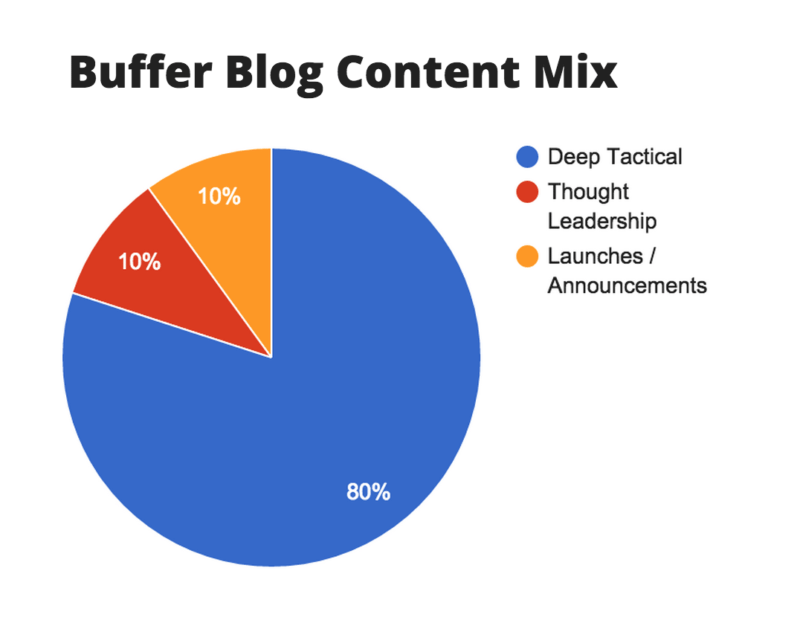
Over to you
How have pivots and changes happened for you and your business?
How can we keep improving the Buffer blog for you?
I’d love the chance to learn from your experiences here and to know how all of this feels to you and your business. Feel free to drop any thoughts at all in the comments. It’d be great to hear from you!
Image sources: Pablo, UnSplash, IconFinder
Try Buffer for free
190,000+ creators, small businesses, and marketers use Buffer to grow their audiences every month.


